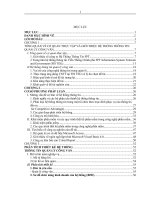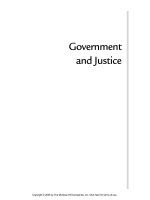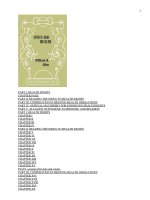Civics and Government
Bạn đang xem bản rút gọn của tài liệu. Xem và tải ngay bản đầy đủ của tài liệu tại đây (194.61 KB, 8 trang )
I
N THIS CHAPTER
, you will learn about the basic ideas of civics (the rights and responsibilities of citizens)
and government (the way that political power is organized and distributed). After an overview of the dif-
ferent types of political systems that exist in other countries, you will review the American system of gov-
ernment: its structure at the federal, state, and local levels; voting and election procedures; political parties; and
the process of becoming an American citizen.
Political Systems
Varying types of political systems can be found around the world. These types differ in how power is attained and
how it is used. See the chart on the next page.
CHAPTER
Civics and
Government
THE PERCENTAGE of civics and government questions on the
2002 GED was greater than in any previous year. The material on the
Social Studies Test will come from both national (American) and global
contexts, so it will be to your advantage to be prepared to answer a
wide variety of questions.
15
143
TYPE OF
GOVERNMENT CHARACTERISTICS EXAMPLES
Monarchy
■
One person from a royal family is ruler.
■
Saudi Arabia
■
Power is inherited from generation to generation.
■
Morocco
■
Absolute monarchs have complete authority. Absolute monarchy:
■
Swaziland
■
Constitutional monarchs have limited authority; Constitutional
a representative democracy governs. monarchies:
■
Great Britain
■
Japan
■
Sweden
Dictatorship
■
It is ruled by one leader who has absolute power over many
■
Nazi (National
aspects of life, including social, economic, and political. Socialist) govern-
■
Leader is not elected by the people. ment of Adolf Hitler
■
General Augusto
Pinochet in Chile
from 1973–1990
Oligarchy
■
It is governed by a small upper-class group.
■
City-state of Sparta
■
Leaders are not elected by the people. in ancient Greece
Democracy
■
In direct democracy, decisions are made by the people. Representative
■
In representative democracy, people elect officials to democracies:
represent their views.
■
United States
■
Canada
■
Most European
nations
–
CIVICS AND GOVERNMENT
–
144
E
XERCISE
6
Use the information from the chart to answer the fol-
lowing questions. The answers are on page 168.
1. A military leader uses his power to overthrow a
country’s government and names himself the
absolute leader of the government. He takes over
all the nation’s television stations and newspa-
pers. What kind of government has he set up?
a. absolute monarchy
b. dictatorship
c. oligarchy
d. direct democracy
e. representative democracy
2. In which of the following political systems would
citizens have the most influence over lawmaking?
a. absolute monarchy
b. dictatorship
c. oligarchy
d. direct democracy
e. representative democracy
The American System of
Government
The United States is a federal republic—a representative
democracy in which power is split between a central
government and the states. To ensure that power is not
concentrated in one authority, the central, or federal,
government is divided into three branches: the legislative,
executive, and judicial. Each branch has an important
function:
■
The legislative branch makes laws.
■
The executive branch carries out laws.
■
The judicial branch interprets laws.
The U.S. Constitution also allows each branch to place
controls or limits on the power of the other two
branches, so that no one branch dominates. This frame-
work is called the system of checks and balances. For
example, the legislature (U.S. Congress) may pass a bill,
but before it can become law, the executive (the presi-
dent) must sign it. The president can refuse it by vetoing
it. However, Congress can still pass the bill into law—in
an action called overriding the veto—if two-thirds of its
members vote for it. (See table at bottom of this page.)
State and Local Governments
State governments resemble the framework of the federal
government. The governor acts as the chief executive and
can veto legislation. Most states have legislatures made of
two houses, and each state has its own court system, con-
stitution, and a system of checks and balances. Local gov-
ernments vary from the state and federal model. There
are three basic forms of local government:
Mayor-council—in this form, voters elect a
mayor as city or town executive and they elect
a council member from each specific ward.
Council-manager—in this form, voters elect
council members, who, in turn, hire a manager
to run the day-to-day operations of the city or
town.
Commission—in this form, voters elect commis-
sioners to head a city or county department,
like the fire, police, or public works
department.
State governments must approve and grant power to, or
charter, all town and city governments.
Political Parties
Although the U.S. Constitution does not mention the
existence of political parties, they have played an influ-
ential role throughout most of the country’s history. A
political party is an organization that presents its posi-
tions on public issues and promotes candidates that sup-
port its point of view.
–
CIVICS AND GOVERNMENT
–
145
STRUCTURE OF FEDERAL GOVERNMENT
Executive Branch President
■
A president is elected by the voters for four-year term.
Vice President
■
A president cannot serve more than two terms.
Agencies
■
Vice president becomes head of state if the president
Departments becomes disabled or dies in office.
■
Agencies carry out a president’s policies and provide special
services.
■
Department heads advise a president and carry out policies.
Legislative Branch U.S. Congress:
■
Number of representatives for each state is based on the
House of population of that state.
Representatives
■
Representatives serve two-year terms.
Senate
■
Each state has two senators.
■
Senators serve six-year terms.
Judicial Branch U.S. Supreme Court
■
U.S. Supreme Court is the highest court in the nation.
Circuit Courts
■
The president appoints the nine justices of the Supreme Court.
of Appeals
■
Term is for life.
Federal District Courts
Political parties serve several functions:
■
recruit candidates and run election campaigns
■
formulate positions on issues that affect the pub-
lic and propose solutions
■
educate the public on issues
■
mobilize their members to vote
■
create voting blocs in Congress
Since the mid-nineteenth century, two political parties
have dominated in American politics: the Republican
and Democratic parties. The two parties differ on social,
economic, and domestic policies. They also hold differ-
ent beliefs as to the role of government. The Republican
Party supports powerful state governments with less
involvement on the federal level, while the Democratic
Party supports a strong centralized government with less
power on the state level. Other current political organi-
zations include the Green, Libertarian, Reform, and
Socialist parties.
E
XERCISE
7
Choose the best answer based on the information pro-
vided about political parties. The answer is on page 168.
1. Which of the following conclusions can you
make about political parties?
a. They should be outlawed because they are not
mentioned in the Constitution.
b. Prior to the nineteenth century, the Green,
Libertarian, Reform, and Socialist parties were
more influential than they are today.
c. Political parties have an influential role in the
political process today.
d. It’s hard to tell the Democratic and Republi-
can parties apart these days.
e. Third-party candidates can alter the outcome
of an election.
Voting and Elections
To vote in the United States, a person must be 18 years
old and a U.S. citizen. Presidential elections occur every
four years, and Congressional elections are held every
two years. Most national elections in the United States
use a plurality system, which means that a candidate need
only receive more votes than his or her opponent to win.
In contrast, some European nations have proportional
representation. In this system, if a political party earns
15% of the vote, it would be awarded 15% of the parlia-
mentary seats.
In the United States, primary elections are held before
general elections. In primaries, voters give their prefer-
ence for a political party’s candidate. General elections
then decide the ultimate winner.
Becoming an American Citizen
Immigrants come to the United States for many reasons:
Some seek economic opportunity, while others wish to
escape political persecution in their native countries.
Benefits of U.S. citizenship include enjoying the free-
doms and rights outlined by the Constitution. To
become a citizen, a person must apply, pass an exam, and
appear for a court hearing. This process, also called nat-
uralization, is conducted by the Immigration and Natu-
ralization Service (INS). The following are some of the
requirements for citizenship. Candidates must:
■
be at least 18 years old
■
reside legally in the United States for five years
■
be a person of good moral character
■
understand and be able to communicate in basic
English
■
demonstrate a basic knowledge of U.S. history,
government, and the Constitution
■
be willing to take an oath of allegiance to the
United States
–
CIVICS AND GOVERNMENT
–
146
E
CONOMICS
is defined as the study of the ways that goods (and services) are bought, sold,
distributed, and used. The economics questions on the GED will require that you have a good grasp
of the relationship of supply and demand, recession and depression, how economic growth is
measured, and how the U.S. government is involved in the nation’s economy.
Types of Economic Systems
None of the three basic economic systems—capitalism, socialism, and communism—exists in pure form. Each has
some characteristics of the others. For example, in the U.S. economy, which is primarily capitalist, the govern-
ment does place some controls over private business in order to protect consumers.
CHAPTER
Economics
ON THE GED, questions about economics will include the areas
of supply and demand, inflation and deflation, and economic systems.
Many economics questions will ask you to interpret and analyze a chart
or graph, so practice in working with visual aids will be helpful in your
preparation.
16
147









